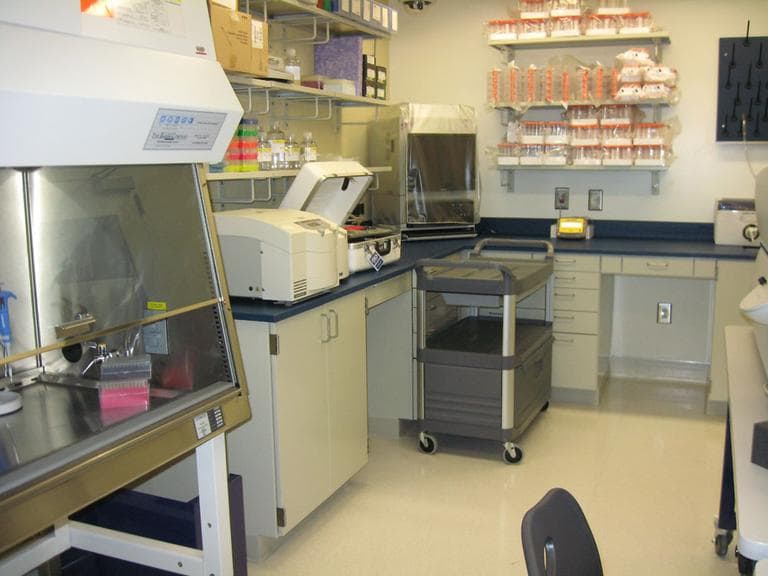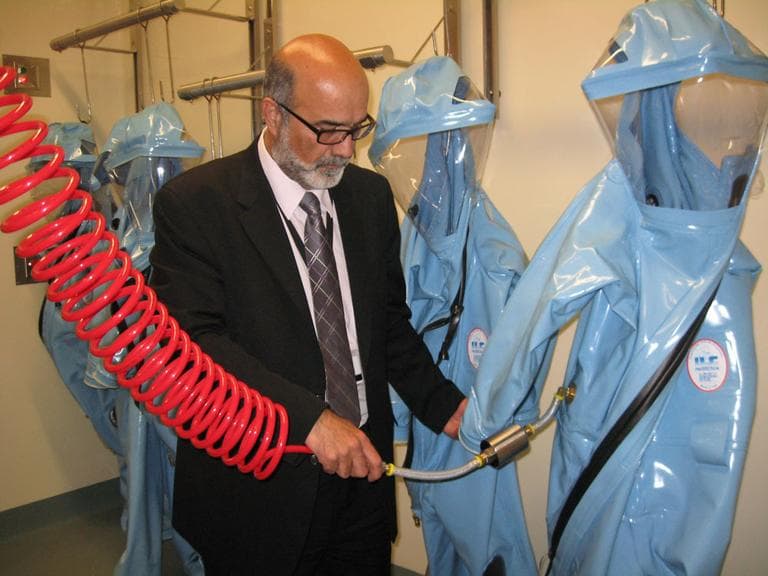Advertisement
Hurdles Remain For South End Infectious Disease Lab
Resume
The names of deadly pathogens, such as Ebola, anthrax and plague, are enough to make some Boston residents shudder and say, "Not in my backyard."
And at a National Institutes of Health meeting at Roxbury Community College Thursday night, the public will get to weigh in on the safety of research on such dangerous organisms proposed to take place at a controversial Boston University lab in the South End.
Local resident Klare Allen is with Safety Net, a neighborhood group that opposes the lab. She says after years of legal challenges and regulatory hurdles, backers of the BU biolab still haven't answered certain questions about what would happen if one of these deadly pathogens was released into the community.
"How are we going to be safe? How are we going to eat?" Allen asked. "How will we be notified? Will there be an alarm? How is it going to be transported? What neighborhoods is it going through?"
This week, WBUR's Bob Oakes toured the lab, officially called the National Emerging Infectious Diseases Laboratories. Research on tuberculosis, which is considered a less dangerous, "level 2" disease, began there earlier this month and security is already high.
After putting our belongings through a scanner and walking through metal detectors, we enter the seven-story, glass-and-concrete lab building. We're met by one of the lab's associate directors, Ara Tahmassian, a microbiologist who's also in charge of research compliance at BU.
Ara Tahmassian: There is a biometric card reader, which is an iris scanner that I have to go through. So if you were to make an attempt to use your iris scanner, and you're not authorized, this will trigger an alarm. So now, this is a typical biosafety level 2 lab. So people will be walking here, putting [on] a lab coat, put their gloves on.
Bob Oakes: So what's in front of us right now are a half-dozen or more rows of long benches of lab work space, where people will eventually be working. It's a huge room. It's probably 75 feet long and 20 feet wide. Not a soul besides our entourage in here.
That's absolutely correct. Actually, there is a parallel to this on the other side, which the biosafety level 2 people who are doing tuberculosis research have already moved in. So as you walk through the room, you will notice that there are what are known as the biosafety cabinets or biological safety cabinets. This is where most of the work will be done. So I would have, let's say, spun this through the centrifuge, but I would be opening this inside of the cabinet, so if there was any airborne pathogens which was released, they would be captured through the filter system.
From there we enter a passageway, where so-called "level 3" researchers will have to put on scrubs, a full-body Tyvek suit, and a filtration hood — which I try on for size.
For me at this moment, because the filtration system isn't pumping any air in here, it's a little hot and it's a little humid, but it would be a lot more comfortable if I was actually working in the lab.

That's correct. The only thing is that you will have to ultimately get used to is now you have air kind of shooting through your face, so there is some level of dehydration.
So I'll be thirsty when I get out of there.
Pretty much, yes.
OK, time to get out. What happens if you have to go to the bathroom when you're in that suit?
You actually try to hold as long as you can, and then you have to go through the sequence.
And come out of the room.
You have to come out of the room. You have to go through a decontamination process. You have to take all of the clothing out, you have to put your street clothing, and get out into the bathroom and then walk through the whole process.
Then we go into one of the level 3 labs — stocked up with lab equipment and supplies, but otherwise vacant.
So what would be studied in this level 3 lab?
Anthrax, plague, Japanese encephalitis virus, for example, is considered as a level 3. And these are the kind of agents that might be studied as we progress with recruitment of the new scientists.
Can I ask you, as a researcher, when you're walking through this building, which seems to me to be pretty much ready to go, is it kind of frustrating that there aren't more people working here?
It is very frustrating because we have a state-of-the-art facility, as you can see. We have the latest equipment and we think that this facility is probably one of the safest.
What would happen if there was research on anthrax, taking place in this room that we're in, and somehow it leaked out? What happens?
Well, that's part of what the risk assessment is addressing. That has taken a number of different scenarios and a number of agents. It sort of has concluded that in almost all of the instances, with the most conservative estimates that they have taken into consideration, the risk to the community is at best negligible. And that has been the practice, and that has been the experience from other facilities. There have been occasional incidents where investigators have gotten infected.
The researchers.
The researchers, who were studying with the agents. But there haven't been, as to best of my knowledge, a secondary infection, which means that they took it out and it sort of got transmitted.
From there, we move to level 4 — the labs where researchers hope to eventually study the most deadly pathogens. Tahmassian shows us a massive room full of HEPA filtration machines specifically dedicated to cleaning the air in those labs. Then he takes us where researchers will don their so-called "space suits."

So if you notice, we have these drop-down air supplies. The first thing that I will do is I will connect the air supply, and I will inflate the suit.
To check it for leaks?
To check it for leaks. Once it's fully inflated, I will disconnect, run my fingers, hand over it, so that there are no leaks, at which point I will put the suit on.
We're standing next to one of these stainless steel doors, outside of a chamber called a chemical shower.
The moment you close that door, automatically it activates a chemical shower. That's a disinfectant.
The hallway itself is sealed. It feels like you're walking through a water-tight compartment on a ship.
Yes, it is. And if you look at every one of the doors and every one of the rooms, they have a very similar design and they're all airtight. Now we're inside of a biosafety level 4 lab. One of the features you will notice as you look at every fixture in the room, it's rounded and there are no sharp edges.
In this level 4 lab, what kind of agents would you work with?
So we have investigators who do research on Marburg, which is Ebola, a type of hemorrhagic fever. However, biosafety level 4 agents, by and large, are not easily transmissible. So person to person transmission is relatively difficult.
This room sort of feels like it's a lady in waiting.
Anxiously waiting for some actual research to be conducted.
Once the National Institutes of Health finalizes its risk assessment report, state and federal agencies and judges have to approve it before biosafety level 3 and 4 research can take place at the Boston University facility. NIH is accepting written comments on the draft report until May 1.
This program aired on April 19, 2012.